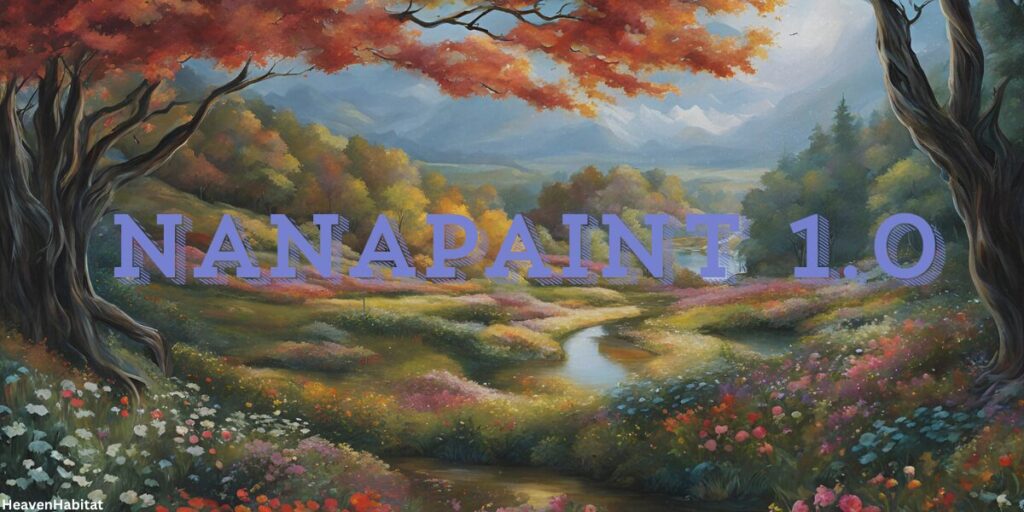A Guide to Nanapaint 1.0: Unveiling Your Artistic Potential

The world of digital art has exploded in popularity in recent years. With the rise of tablets and affordable computers, anyone can now explore their creative side and create stunning artwork. But for those new to the digital canvas, the sheer number of software options can be overwhelming.
Fear not, aspiring artists! Nanapaint 1.0 is here to bridge the gap. This free and user-friendly digital painting software is specifically designed for beginners and hobbyists. With its intuitive interface and basic yet powerful tools, Nanapaint 1.0 provides the perfect platform to unleash your inner artist and embark on your digital art journey.
This comprehensive guide is tailored specifically for those taking their first steps into the exciting world of digital painting. Whether you’re completely new to the concept or simply curious about what Nanapaint 1.0 has to offer, we’ll walk you through everything you need to know to get started.
Contents
Demystifying Nanapaint 1.0: A Beginner’s Paintbox
Nanapaint 1.0 is a free and lightweight digital painting software. Unlike complex professional programs, Nanapaint focuses on providing a simple and accessible platform for creating raster graphics, which are essentially digital images formed by pixels. Think of it as your virtual canvas, ready to be brought to life with vibrant colors and creative strokes.
The beauty of Nanapaint 1.0 lies in its beginner-friendly design. Here’s what makes it perfect for aspiring artists:
- Intuitive Interface: Nanapaint boasts a clean and uncluttered interface. Unlike some feature-laden programs that can be intimidating, Nanapaint keeps things straightforward. You’ll find only the essential tools you need readily available, without overwhelming menus or cryptic options.
- Basic Brush Tools: Nanapaint offers a core set of essential brush tools that cater to a variety of artistic needs. You can create smooth lines, experiment with different brush sizes and textures, and even fill in areas with ease. While it may not have the extensive brush libraries found in professional software, Nanapaint provides a solid foundation for exploring digital painting techniques.
- Color Palette: Unleash your creativity with a customizable color palette. Nanapaint allows you to mix colors directly on the canvas, just like a traditional artist. Additionally, you can save your favorite color combinations for easy access in future projects.
Standing Out from the Crowd (Optional Comparison):
While there are other free and beginner-oriented digital painting programs available, Nanapaint 1.0 sets itself apart with its exceptional ease of use. Compared to software with a steeper learning curve, Nanapaint allows you to jump right in and start creating without getting bogged down in complex features. This makes it ideal for absolute beginners who want to experiment with digital art without feeling overwhelmed.
Now that you understand the core functionality and user-friendly nature of Nanapaint 1.0, let’s dive into getting you set up and ready to create!
Setting Up Your Nanapaint 1.0 Studio: A Step-by-Step Guide
Before you unleash your creativity, let’s get you set up with Nanapaint 1.0. Here’s a step-by-step guide to get you started:
Downloading and Installation:
- Head over to the official Nanapaint website (https://tuxpaint.org/download/) or a reputable software download platform.
- Download the Nanapaint 1.0 installer specific to your operating system (Windows, macOS, etc.).
- Run the downloaded installer and follow the on-screen instructions to complete the installation process. Nanapaint is a lightweight program, so the installation should be quick and straightforward.
Taking Command: Essential Nanapaint 1.0 Actions
Now that you’re comfortable with the layout, let’s explore some fundamental controls to bring your artistic vision to life:
Navigating Your Canvas:
Nanapaint allows you to move around your digital canvas with ease. Click and drag anywhere on the canvas to pan (move) it in the desired direction. Use the zoom controls (often located in the toolbar) to adjust the magnification and focus on specific details. Zooming in allows for more precise brushstrokes, while zooming out gives you a broader view of your entire artwork.
Selecting the Perfect Brush:
The toolbar provides a variety of brush options. Click on a brush icon to select it. Experiment with different brushes to find ones that suit your artistic style. Many brushes offer adjustable size and opacity settings using sliders (often located next to the brush options). A larger brush size is ideal for covering large areas quickly, while a smaller size allows for finer details. Adjusting the opacity controls the transparency of your brushstrokes. A lower opacity creates a more translucent effect, allowing the underlying colors to show through.
Picking Your Colors:
Select a foreground color from the color palette by clicking on the desired color. You can also use the eyedropper tool (if available) to pick a color directly from your canvas. This is helpful for matching existing colors in your artwork or incorporating elements from reference images.
Saving Your Masterpiece:
It’s crucial to save your artwork regularly to avoid losing your progress. Click on the “File” menu (or equivalent option) and choose “Save” to save your creation as a .NPN file (Nanapaint’s native format). Nanapaint also allows you to export your artwork in other common image formats like .JPG or .PNG for wider compatibility. Choosing the right export format depends on how you plan to use the image. Pro Tip: Consider saving your work in both .NPN format (to preserve Nanapaint-specific editing capabilities) and an exportable format like .JPG for easy sharing.
With these fundamental controls mastered, you’ve taken the first steps towards becoming a digital artist with Nanapaint 1.0. In the next section, we’ll delve deeper into Nanapaint’s features to unlock your full creative potential
Unveiling Nanapaint 1.0’s Creative Toolkit
Now that you’ve mastered navigating your Nanapaint canvas, let’s delve into the features that bring your artistic vision to life. We’ll explore essential tools like brushes and colors, along with some additional features that might be available in your specific Nanapaint version.
Mastering the Brush: Exploring Brush Options and Settings
Nanapaint 1.0 provides a core set of brush options that cater to a variety of artistic needs. Here’s a breakdown of some common brushes and how to use them effectively:
- Round Brush: Your artistic workhorse, the round brush is perfect for creating lines, strokes, and filling in areas. Experiment with different sizes to achieve thin, precise lines for details or bold, sweeping strokes for backgrounds.
- Flat Brush: This brush lays down color in flat, even strokes, making it ideal for filling large areas or creating blocky shapes. It’s a great tool for base coats or creating graphic design elements.
- Airbrush: Simulating the effect of a spray gun, the airbrush allows for soft, blended applications of color. Use it for creating gradual transitions, adding shadows and highlights, or achieving a smooth, airbrushed finish.
Adjusting Brush Settings for Artistic Control
Nanapaint 1.0 allows you to customize your brushes for further creative exploration. Here’s how to adjust brush settings:
- Size: Look for the size slider (often located near the brush options in the toolbar). Dragging the slider left reduces the brush size for finer details, while dragging right increases it for broader strokes.
- Opacity: This setting controls the transparency of your brushstrokes. A lower opacity creates a more translucent effect, allowing underlying colors to show through. Use a higher opacity for more solid, opaque strokes.
Don’t be afraid to experiment with different brush options and settings to discover what works best for your artistic style.
A World of Color at Your Fingertips: Exploring the Color Palette
Nanapaint’s color palette is your gateway to a vibrant spectrum of colors. Here’s how to utilize it to its full potential:
- Predefined Colors: The palette offers a range of preset colors, providing a convenient starting point for your artwork. Click on a color to select it as your foreground color.
- Mixing Custom Colors: Unleash your inner colorist by mixing custom colors directly on the palette. Click and hold on a color, then drag your mouse to a different color on the palette. Nanapaint will blend the two colors, creating a new hue.
- Saving Custom Palettes (if available): Some versions of Nanapaint allow you to save your favorite custom color combinations as palettes. This can save you time and ensure consistency across your artwork.
Selection Tools: Refining Your Work
Nanapaint offers basic selection tools that allow you to manipulate specific areas of your artwork:
- Selecting Areas: Click and drag your mouse to create a rectangular selection around the portion of your artwork you want to modify.
- Copying and Pasting: Once you have a selection, you can copy it to the clipboard (a temporary storage area within Nanapaint) and then paste it elsewhere on your canvas. This is useful for duplicating elements or creating mirrored images.
Level Up Your Nanapaint 1.0 Skills
Now that you’re familiar with Nanapaint’s core functions, let’s explore some valuable tips and tricks to elevate your digital art creations and make the most of this beginner-friendly software.
Embrace the Power of Practice
As with any creative skill, mastering digital painting takes time and dedication. The key to improvement lies in consistent practice. Here’s how to make Nanapaint your go-to practice tool:
Short Daily Sessions: Set aside some time each day, even if it’s just for 15-30 minutes, to practice in Nanapaint. Regular practice, even in short bursts, helps solidify your understanding of the tools and techniques.
Targeted Exercises: Dedicating short sessions to specific exercises can be highly beneficial. Focus on practicing brushwork, color mixing, or exploring different drawing techniques. There are many online tutorials (more on that later!) that offer structured exercises for beginners.
The Inspiration Highway: Online Resources
The vast world of the internet offers a treasure trove of resources to fuel your artistic journey with Nanapaint. Here’s how to tap into this valuable resource pool:
Nanapaint Tutorials: A quick online search will reveal a plethora of Nanapaint tutorials. These tutorials can guide you through specific techniques, introduce new features you might not have discovered, or even offer step-by-step guides for creating specific art pieces.
Digital Art Communities: Joining online communities dedicated to digital art or Nanapaint specifically can be a source of immense inspiration and learning. Interact with other artists, share your work, and get valuable feedback to help you improve.
Sample Artwork Galleries: Immersing yourself in the work of other Nanapaint artists can spark inspiration and ignite your creativity. Explore online galleries showcasing Nanapaint artwork to discover new techniques, color palettes, and artistic styles.
Experimentation is Key: Unleashing Your Inner Artist
Nanapaint’s beauty lies in its simplicity, allowing you to experiment freely and discover your artistic voice. Here’s how to embrace experimentation in your artistic journey:
Brush Exploration:
Don’t be afraid to try out all the different brush options available in Nanapaint. Play around with their size and opacity settings to see how they affect your strokes. Experiment with using different brushes for various purposes – the round brush for detailed lines, the flat brush for filling large areas, and the airbrush for soft shading.
Color Mixing Adventures:
Nanapaint’s color palette opens a world of color possibilities. Don’t just rely on the preset colors. Take the time to mix your own custom colors and explore the vast spectrum of hues you can create. Observe how colors interact with each other, and experiment with creating vibrant or muted palettes depending on the mood you want to convey in your artwork.
Embrace Happy Accidents:
Sometimes, the most unexpected results can lead to creative breakthroughs. Don’t be afraid to let loose and experiment with different techniques. Happy accidents can spark new ideas and help you develop your unique artistic style.
Remember, there are no mistakes in art, only exploration and discovery. With these tips and tricks, along with a healthy dose of practice and exploration, you’ll be well on your way to creating stunning digital art masterpieces with Nanapaint 1.0.
FAQ’s: Nanapaint 1.0
Q- What kind of paint should a beginner start with?
A: For beginners, acrylic paints are a fantastic choice. They’re easy to use, clean up with water, dry quickly, and offer a versatile range of colors and techniques.
Q- Which art is best for beginners?
A: There isn’t a single “best” art style, but some are more forgiving for beginners:
- Abstract Art: Focuses on color, texture, and composition, allowing for experimentation.
- Still Life: Drawing or painting simple objects helps practice basic techniques.
- Landscapes: Starting with basic shapes for landscapes eases you into composition and color mixing.
Ultimately, choose an art form that interests you!
Q- Which acrylic is best for beginners?
A: This depends on your preference and budget, but some popular student-grade acrylic brands known for affordability and quality include:
- Liquitex Basics Acrylics
- Golden Fluid Acrylics (student grade)
- Winsor & Newton Galeria Acrylics
- M. Graham Acrylics
Remember, these are suggestions. Research different brands to find the best fit for you.
Nanapaint 1.0 – The Final Reel
Now that you’re armed with the knowledge and essential tools, it’s time to take the plunge! Download Nanapaint 1.0 today and embark on your digital art adventure. Remember, the key to artistic growth lies in practice and exploration. Don’t be afraid to experiment, have fun, and let your creativity flow!
The Nanapaint development community is dedicated to continuous improvement. While there’s no official roadmap for future updates, you can always check the official website or online forums for any upcoming features or bug fixes that might further enhance your Nanapaint experience. We hope this comprehensive guide has empowered you to get started with Nanapaint 1.0. Happy creating!









1 thought on “A Guide to Nanapaint 1.0: Unveiling Your Artistic Potential”